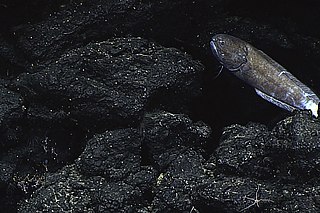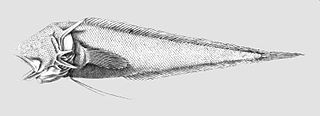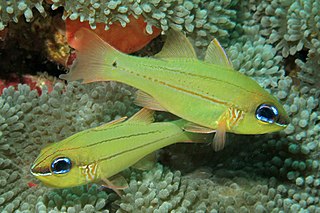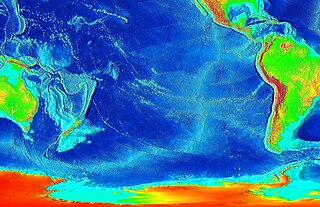
Rendahl's messmate, Echiodon rendahli, is a pearlfish of the family Carapidae, found in the southwest Pacific Ocean around Australia and New Zealand at depths to 60 metres (200 ft). Its length is between 10 and 12 centimetres .The larvae has a long filament on its head which bears some resemblance to a siphonophore. These fish live within sponges. The specific name honours the Swedish naturalist and artist Hialmar Rendahl who collected the specimens in the Tasman Sea which were used by Gilbert Percy Whitley to describe this species.

Hector's goby is a species of goby native to the Indian Ocean to the islands of Micronesia in the western Pacific Ocean. It can be found on sheltered coral reefs at depths of from 3 to 30 metres. This species reaches a length of 8.5 centimetres (3.3 in) SL. It can also be found in the aquarium trade. The specific name honours Gordon Hector who was Chief Secretary to the Government of the Seychelles, in gratitude for his help to Smith’s work in the Seychelles.
Thermichthys hollisi is a species of viviparous brotula found in the Galapagos Rift Zone at depths of 2,500 metres (8,200 ft) around thermal vents. This species is the only known member of its genus. The specific name honours the submersible pilot Raplph Hollis who captured specimens of this fish.
Onuxodon is an Indo-Pacific genus of pearlfishes from the family Carapidae. The generic name is derived from the Greek onyx meaning "claw" and odon meaning "tooth", referring to the sharp fang like teeth of Onuxodon parvibrachium. Species in this genus are distributed from South Africa to Hawaii. They live commensally with molluscs. The three currently recognized species are:

Snyderidia canina is a species of pearlfish found in all tropical waters but those of the eastern Pacific Ocean, depths from 110 to 1,762 m. This species grows to a length of 26.8 cm (10.6 in). This fish is the only known species in its genus which was named in honour of the ichthyologist John Otterbein Snyder (1867-1943) for the assistance he lent to Charles Henry Gilbert on the cruise to Hawaii on which the type specimen was collected.
Alcockia is a genus in the cusk-eel family. It contains only the single species Alcockia rostrata, which is found in the Indian and western Pacific Oceans, at depths of from 2,761 to 4,040 metres. This species grows to a length of 35 centimetres (14 in) SL. The generic name Alcockia honours Alfred William Alcock (1859-1933) who was the surgeon-naturalist aboard the R.I.M.S. Investigator.
Bassogigas gillii is a species of cusk-eel found in the Indian, Pacific Ocean, and Atlantic Oceans at depths of from 637 to 2,239 metres.
Bassogigas is a genus of cusk eel from the subfamily Neobythitinae, part of the family Ophidiidae. The generic name "Bassogigas" comes from a combination of two Latin words: bassus, which means "deep" and gigas which means "giant". The species are found in the Indo-Pacific and western Atlantic Ocean.
The Australian tusk, Dannevigia tusca, is a species of cusk-eel found in the waters off of the Great Australian Bight occasionally to Bass Strait at depths from 115 to 400 m. This species grows to 56 cm (22 in) in total length. It is the only known member of its genus and the generic name honours Harold Christian Dannevig (1860-1914) who was the Director of Fisheries for the Australian government, who collected type specimen and who was later lost at sea when the fisheries research vessel he was working on vanished without a trace.

The needletooth cusk is a species of cusk-eel found in the Indian and the western Pacific Ocean where it occurs at depths of 1,000 to 1,750 metres. This species grows to a length of 21.5 centimetres (8.5 in) SL. It is the only known species of its genus The generic name is a compound of the Greek epetrion meaning "needle" and odous meaning "tooth", while the specific name honours the English ichthyologist Norman Bertram “Freddy” Marshall (1915-1996) who worked on deep sea fishes as the British Museum.
The banded cusk-eel is a species of cusk-eel found along the southeast coast of South America from southern Brazil to northern Argentina. It occurs at depths of from 40 to 150 metres and is of minor importance in commercial fisheries. This species grows to a length of 31 centimetres (12 in) TL. It is the only known member of its genus. The generic name honours the American ichthyologist Edward C. Raney (1909-1984) of Cornell University who introduced the describer Charles R. Robins to ichthyology.

Sirembo is a genus of cusk-eels of the subfamily Neobythitinae, family Ophidiidae, which are found in the Indian and Pacific Oceans. The species in this genus have a rather robust body with the dorsal fin originating over vertebrae 1–5. The head and bod are completely covered in scales, they have large eyes which are almost equal in diameter to the length of snout, the pelvic fins have two rays which are joined together within an area of tough skin, They have a short spine on the operculum which does not extend to the posterior edge of the head. Their coloration is variable but almost all species have black spots or eyespots on the dorsal fin, sometimes both, while the middle part of the anal fin frequently has a black band. The body and/or head are marked with diagonal or horizontal dark stripes or horizontal rows of quite large dusky spots.

Tauredophidium hextii is a species of cusk-eel found in the Indian and western Pacific Oceans. It occurs at depths of from 1,500 to 2,660 metres. This species grows to a length of 10.5 centimetres (4.1 in) SL. It is the only known member of its genus. The specific name honours Rear-Admiral John Hext (1842-1924) who was commander of the Royal Indian Marine who supported the expedition in board the R.I.M.S. Investigator in the Arabian Sea which collected the type specimen.
The gargoyle cusk is a species of cusk-eel from the subfamily Neobythitinae of the family Ophidiidae. This species grows to a length of 57 centimetres (22 in) TL. It is the only known member of its genus. The specific name honours George S. Myers (1905-1985) of Stanford University who taught the describer, Daniel Cohen, ichthyology. It is a rare benthopelagic fish which occurs at depths of 984–2,500 metres (3,228–8,202 ft) around the world, other than the eastern Pacific, in tropical and subtropical latitudes.

Roche's snake blenny is a fish species in the genus Ophidion and the family Ophidiidae. Widespread in the Mediterranean Sea in western and northern regions, also in the Black Sea, Sea of Marmara and it has been recorded in the Atlantic. Marine subtropical demersal fish, up to 29.3 centimetres (11.5 in) long. The specific name honours the Swiss physician and naturalist François-Etienne Delaroche (1780-1813), who wrote about the distinctive swim-bladder anatomy of Ophidion barbatum in 1809.

Ophidion josephi is a fish species in the family Ophidiidae. Widespread in the Western Atlantic from Georgia to Florida, also in the Gulf of Mexico. Marine tropical demersal fish. The specific name josephi refers to St Joseph Island in Texas where the type specimen was collected.
Basketweave cusk-eel is a fish species in the family Ophidiidae. It is widespread in the Eastern Pacific Ocean from Point Arguello in California, United States, to Baja California. The basketweave cusk-eel is a marine subtropical demersal fish that can be up to 28 centimetres (11 in) long. The specific name honours the journalist and philanthropist Ellen B. Scripps (1836-1932) one of the founders of the Scripps Research Institute.

Ostorhinchus sealei, Seale's cardinalfish or the cheek-barred cardinalfish, is a species of ray-finned fish, a cardinalfish, from the family Apogonidae. It is an Indo-Pacific species which ranges from Malaysia east to the Solomon Islands, north to southern Japan and south to northwestern Australia, as well as Palau in Micronesia. It is an uncommon species which occurs among branching corals in the sheltered lagoons protected by reefs. It can be found in small to large aggregations low in the water over the reef. It is infrequent below depths of 10 metres (33 ft). They are mouthbrooders which form pairs to mate. During the day thse fish shelter in the reef and they emerge at night to feed on zooplankton and benthic invertrebrates. The specific name honours the American ichthyologist Alvin Seale (1871-1958).
Echinogobius hayashii, the cheek-streaked goby, is a species of goby native to the eastern Indian Ocean and the western Pacific Ocean from Australia to Japan. This species can be found at depths of from 1 to 20 metres living in areas with strong tidal currents and a sandy substrate. This species grows to a length of 7 centimetres (2.8 in) SL. This species is the only known member of its genus. The specific name honours Masayoshi Hayashi, a curator at Yokosuka City Museum, who collected the type specimens.
The flagtail wormfish is a species of wormfish native to the Pacific coast of the Americas from Mexico to Colombia as well as the Galápagos Islands. It is an inhabitant of tide pools and reefs being found down to a depth of about 8 metres (26 ft). This species grows to a length of 6.2 centimetres (2.4 in) SL. This species is the only known member of its genus. The generic name is a compound noun made up of the surname Clark, to honour the American ichthyologist H. Walton Clark (1870-1941) who described the species and ichthys the Greek for "fish".









